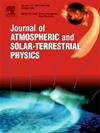强降雨条件下三条连续飑线的双极化特征
IF 1.8
4区 地球科学
Q3 GEOCHEMISTRY & GEOPHYSICS
Journal of Atmospheric and Solar-Terrestrial Physics
Pub Date : 2025-01-01
DOI:10.1016/j.jastp.2024.106404
引用次数: 0
摘要
基于s波段双极化气象雷达资料,分析了2021年5月26日(案例A)、2021年6月30日(案例B)和2021年7月31日至8月1日(案例C)三条强降水飑线的动力和云物理结构特征。结果表明:(1)3条飑线低层强回波区聚集了高浓度的大液体颗粒,且以飑线锋面两侧为主;回波高值区包含融化的小冰雹颗粒,弓形回波区主要由小液体颗粒组成。(2)从垂直结构上看,飑线前后有不同的结构特征。在风暴的前部有KDP和ZDR纵队。与KDP柱相比,ZDR柱的高度更高。强上升气流区主要由低浓度液体大颗粒组成,在ZDR柱- 10℃高度以下观测到少量融化的冰颗粒。在10℃高度以上,ZDR值相对较小,主要由霰颗粒组成。在风暴后ZDR高值区下方,有液态大颗粒和融化的小冰雹颗粒。在这个高度以上,成分主要是霰或冰粒。(3)每分钟降水量存在一定差异,但最大的差异表现在降水持续时间上。其中,由于A情况下飑线的雨滴直径最大,故在C情况下观测到的ZH和ZDR最大,在C情况下观测到的ZH和ZDR最小。C情况下,降水超过2 mm / min。与1 ~ 2 mm/min范围相比,ZDR和相关系数(CC)基本保持不变,但KDP较大。降水颗粒浓度高,降水效率显著提高,每分钟降水强度增大。本文章由计算机程序翻译,如有差异,请以英文原文为准。
Dual polarization characteristics of three consecutive squall lines with heavy rainfall
Herein, the dynamic and cloud physical structure characteristics of three squall lines with heavy precipitation on May 26, 2021 (Case A), June 30, 2021 (Case B) and July 31 to August 1, 2021 (Case C) were analyzed based on S-band dual polarization weather radar data. The results showed that: (1) High concentrations of large liquid particles accumulated in the low-level strong echo areas of the three squall lines, with predominant presence on both sides of the front of the squall line. The high-value area of the echo contained melted small hail particles, whereas the bow-shaped echo area was primarily composed of small liquid particles. (2) From vertical structures, different structural characteristics were observed on the front and back of the squall line. There were KDP and ZDR columns on the front side of the storm. The ZDR column exhibited a greater height compared to the KDP column. The strong updraft zone was primarily composed of low-concentration liquid large particles, with a small amount of melted ice particles observed below the height of the −10 °C level within the ZDR column. Above the height of 10 °C level, the ZDR value was relatively small, mainly composed of graupel particles. Below the zone of the ZDR high value behind the storms, there were liquid large particles and melted small hail particles. Above this height, the composition was mainly graupel or ice particles. (3) There is a certain difference in the amount of precipitation per minute, but the biggest difference is manifested in the duration of precipitation. Among them, due to the largest raindrop diameter of the squall line in Case A, ZH and ZDR were the largest, and the smallest ZH and ZDR were observed in Case C. In Case C, the precipitation exceeded 2 mm per minute. A comparison with the 1–2 mm/min range revealed that ZDR and correlation coefficient (CC), remained essentially the same, but KDP was larger. The high concentration of precipitation particles resulted in a significantly higher rainfall efficiency, leading to a greater intensity of precipitation per minute.
求助全文
通过发布文献求助,成功后即可免费获取论文全文。
去求助
来源期刊

Journal of Atmospheric and Solar-Terrestrial Physics
地学-地球化学与地球物理
CiteScore
4.10
自引率
5.30%
发文量
95
审稿时长
6 months
期刊介绍:
The Journal of Atmospheric and Solar-Terrestrial Physics (JASTP) is an international journal concerned with the inter-disciplinary science of the Earth''s atmospheric and space environment, especially the highly varied and highly variable physical phenomena that occur in this natural laboratory and the processes that couple them.
The journal covers the physical processes operating in the troposphere, stratosphere, mesosphere, thermosphere, ionosphere, magnetosphere, the Sun, interplanetary medium, and heliosphere. Phenomena occurring in other "spheres", solar influences on climate, and supporting laboratory measurements are also considered. The journal deals especially with the coupling between the different regions.
Solar flares, coronal mass ejections, and other energetic events on the Sun create interesting and important perturbations in the near-Earth space environment. The physics of such "space weather" is central to the Journal of Atmospheric and Solar-Terrestrial Physics and the journal welcomes papers that lead in the direction of a predictive understanding of the coupled system. Regarding the upper atmosphere, the subjects of aeronomy, geomagnetism and geoelectricity, auroral phenomena, radio wave propagation, and plasma instabilities, are examples within the broad field of solar-terrestrial physics which emphasise the energy exchange between the solar wind, the magnetospheric and ionospheric plasmas, and the neutral gas. In the lower atmosphere, topics covered range from mesoscale to global scale dynamics, to atmospheric electricity, lightning and its effects, and to anthropogenic changes.
 求助内容:
求助内容: 应助结果提醒方式:
应助结果提醒方式:


